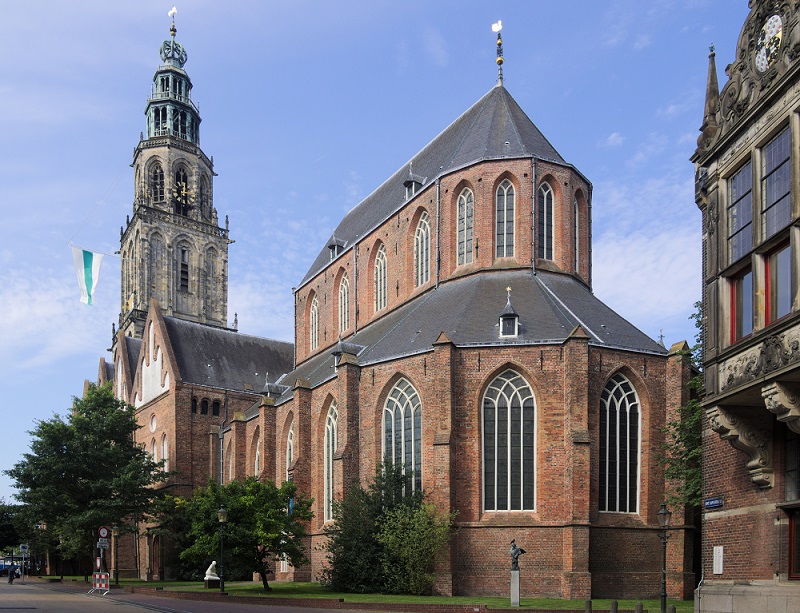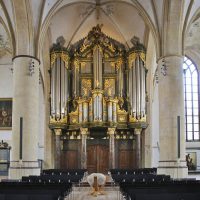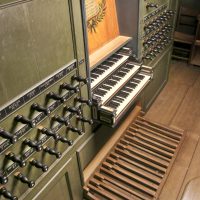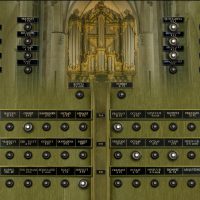
The history of the Martini organ dates back to 1450, when master Hermannus built an organ and placed it in a new gallery. Later it was expanded with a rugwerk and a bovenwerk and further additions. From 1685 to 1690, Jan Helman began extensive work, including new bellows, keyboards, and spring chests for the Hoofdwerk and Pedaal, but died in 1690, leaving some of the work unfinished. The parish then contacted Arp Schnitger, who completed the work. Schnitger built large pedal towers on both sides of the organ and placed the 32-foot Prestant pipes in the front. Schnitger also built three reed stops and a new wind chest for the Bovenwerk. He eventually lowered the pitch of the organ by moving all the pipes one step. Through all these actions, the organ received the signature of Arp Schnitger.
In the 19th century, the Martini organ was adapted several times to the then fashionable tastes and the disposition was romanticized. In the second half of the 20th century, the organ builder Jürgen Ahrend and organologist Cornelis H. Edskes together made plans for restoration work, first in 1976/77 and then in 1983/84. The work included the reconstruction of the mechanical action, the construction of a new wind supply and the restoration of the wind chests. The old pipes were restored to their Baroque voicing and the organ was brought back to the disposition of 1740 – although some 19th century registers have also been preserved in the current instrument with an adapted voicing. Ahrend even reconstructed the original speelfluit 4′, of which only a single pipe from 1542 was preserved in the local museum. The organ now consists of 53 speaking stops.
- Now available for playing in your own living room
- Full surround 8-channel (direct, diffuse, distant, rear)
- High-quality samples
- Only suitable for Hauptwerk 5
Would you like more information about purchasing this sample set or the transition to Hauptwerk 5? Please contact us.
Disposition:
| Rugwerk (I): | Hoofdwerk (II): | Bovenwerk (III): | Pedaal: | |||
| Quintadena 16´ | Praestant 16´ | Praestant 8´ | Praestant 32´ | |||
| Praestant 8´ | Octaav 8´ | Holfluyt 8´ | Praestant 16´ | |||
| Roerfluyt 8´ | Salicet 8´ | Octaav 4´ | Subbas 16´ | |||
| Bourdon 8´ | Quintadena 8´ | Nasat 3´ | Octaav 8´ | |||
| Octaav 4´ | Gedackt 8´ | Mixtuur 4-6 st. | Gedackt 8´ | |||
| Speelfluyt 4´ | Octaav 4´ | Sexquialter 2 st. | Roerquint 6´ | |||
| Gedacktquint 3´ | Gedackt fluyt 4´ | Trompet 16´ | Octaav 4´ | |||
| Nasat 3´ | Octaav 2´ | Vox Humana 8´ | Octaav 2´ | |||
| Octaav 2´ | Vlakfluyt 2´ | Nagthoorn 2´ | ||||
| Fluyt 2´ | Mixtuur 4-6 st. | Mixtuur 4 st. | ||||
| Mixtuur 4-6 st. | Scharp 4 st. | Bazuyn 16´ | ||||
| Sexquialter 2 st. | Tertiaan 2 st. | Dulciaan 16´ | ||||
| Cimbel 3 st. | Trompet 8´ | Trompet 8´ | ||||
| Basson 16´ | Viola d. Gamba 8´ | Cornet 4´ | ||||
| Schalmey 8´ | Cornet 2´ | |||||
| Hautbois 8´ | ||||||
| Bazuyn 32´ (ext.) |
- RW tremulant
- BW tremulant – affecting also RW, HW and Pedaal Cornet 2´.
- Coupler HW-RW, Coupler BW-HW





